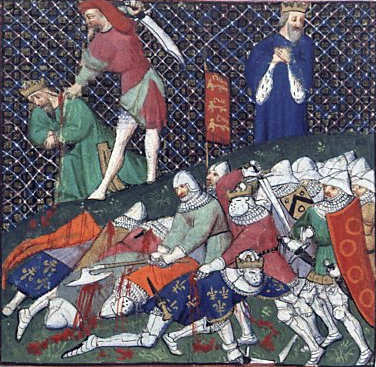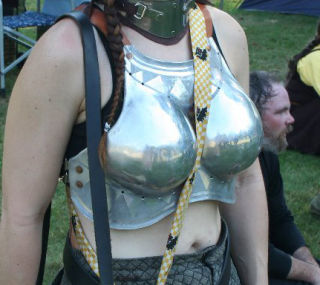Inspired by my previous post on the subject of ransoms, what follows hereafter is a basic system of ransom for use in 1e AD&D. I've decided to go for 1e AD&D from the outset, so that things keep fairly simple for now. This is also a first draft, so somewhere along the line it may get rewritten, adjusted, etc.
Ransoms
Players may find themselves in a situation where they have captured someone of value to another person, society, place etc, and that this can be used for financial gain in some way. This doesn't always mean that the players are involved in a form of absolute extortion - they may be well justified in seeking ransom for some past wrong-doing. The idea of ransoming a person for money (or some other equivalent form) may appear abhorrent to some players and character types. For example, would a Paladin really indulge in such measures? Well, possibly. A ransom could be seen as a way of paying pennance or a method by which a grievance is settled. Ransom could be a system through which another party is being forced to pay for the misdeeds of the captive. Of course, the players may end up in a situation where they themselves are the captives, and so this system could also be used to measure their apparent worth.
Step One: Market Forces, basic values
The basic price on the head of any given character class could vary from place to place, depending on the apparent worth of that person's class. For example, the players may be adventuring in a place where more value is given to those persons engaging in magical practices. A town that is a haven for thieves may place greater value on one of their own kind than, say, a magic-user. That said, we can perhaps start from some simple premise of a baseline value (in gold pieces) for each character class at 1st level:
Cleric 20
Druid 20
Fighter 30
Paladin 40
Ranger 30
Magic-User 30
Illusionist 20
Thief 10
Assassin 10
Monk 15
Henchman 10
Hireling 10
Of course, 1st level characters will probably not be of much worth to someone else. Other factors will affect their value. Henchmen and hirelings are included on this list because they also have some basic value to other players, NPCs etc and therefore the following steps may also apply to them.
Step Two - Level multiplier
A level multiplier is then applied to the base number above.
Example: a 5th level Paladin is worth 200gp (5x40gp).
Step Three - Status multiplier
Status denotes the apparent value an individual has in terms of social standing, if relevant. This will of course vary from place to place, depending on how the person is viewed by others. If we take the idea of some form of community role or nobility as an example, we could apply these multipliers:
Local mayor x2
Minor nobility x3
Direct descendant of local king x5
Local king x10
Example: a 5th level Paladin who is the son of a local king is worth 1000gp (5x200gp).
Ransoms
Players may find themselves in a situation where they have captured someone of value to another person, society, place etc, and that this can be used for financial gain in some way. This doesn't always mean that the players are involved in a form of absolute extortion - they may be well justified in seeking ransom for some past wrong-doing. The idea of ransoming a person for money (or some other equivalent form) may appear abhorrent to some players and character types. For example, would a Paladin really indulge in such measures? Well, possibly. A ransom could be seen as a way of paying pennance or a method by which a grievance is settled. Ransom could be a system through which another party is being forced to pay for the misdeeds of the captive. Of course, the players may end up in a situation where they themselves are the captives, and so this system could also be used to measure their apparent worth.
Step One: Market Forces, basic values
The basic price on the head of any given character class could vary from place to place, depending on the apparent worth of that person's class. For example, the players may be adventuring in a place where more value is given to those persons engaging in magical practices. A town that is a haven for thieves may place greater value on one of their own kind than, say, a magic-user. That said, we can perhaps start from some simple premise of a baseline value (in gold pieces) for each character class at 1st level:
Cleric 20
Druid 20
Fighter 30
Paladin 40
Ranger 30
Magic-User 30
Illusionist 20
Thief 10
Assassin 10
Monk 15
Henchman 10
Hireling 10
Of course, 1st level characters will probably not be of much worth to someone else. Other factors will affect their value. Henchmen and hirelings are included on this list because they also have some basic value to other players, NPCs etc and therefore the following steps may also apply to them.
Step Two - Level multiplier
A level multiplier is then applied to the base number above.
Example: a 5th level Paladin is worth 200gp (5x40gp).
Step Three - Status multiplier
Status denotes the apparent value an individual has in terms of social standing, if relevant. This will of course vary from place to place, depending on how the person is viewed by others. If we take the idea of some form of community role or nobility as an example, we could apply these multipliers:
Local mayor x2
Minor nobility x3
Direct descendant of local king x5
Local king x10
Example: a 5th level Paladin who is the son of a local king is worth 1000gp (5x200gp).
The Dungeon Master would have to exercise some reasoning here with regard to henchmen and hirelings - for example, an expert blacksmith in a city that has other blacksmiths may not have a much status as one who is the only blacksmith for miles around. Out in the wilds, a whole area may rely on his or her skills. Thus, the city expert is akin to a x2 ('local mayor'), whereas the rare and valuable blacksmith is x5 or possibly even x10.
Step Four - Fame multiplier
Fame is another form of social standing that may also supercede that individual's social status. What drives that in terms of overall value is how well the fame is known over a distance. A village hero of great worth to his local people could be unheard of in a town 50 miles away. The following multipliers could apply:
x2 (the person is known to the local population)
x3 (the person is known to the local area)
x5 (the person known to a kingdom)
x20 (the person known to whole land)
A local area, land, or kingdom may be relatively small - what matters is how many other people know the the person's fame and how important it is to them a whole. Even the ruler of one kingdom may be of little value to another, depending on their perceived worth. A leader of an army of thieves might be famous across a whole land within which lie several kingdoms.
Example: a 10th level Thief king who is known throughout a whole land is worth 20000gp - 10gp x 10th lvl =100gp, x10 (local king) = 1000gp, x20 (known to a whole land).
Non-Human Followers
It's possible that certain high level players have non-human followers, and that those followers may also have some level of status and/or fame. If so, take the non-human's hit dice, multiply it by the gp value below, and then apply Steps Three and Four if required:
Centaur 200
Hippogriff 200
Pegasus 300
Brownie 100
Pixie 100
Pseudo-dragon 350
Satyr 300
Sprite 200
Copper Dragon 500
Storm Giant 1000
Treant 300
Werebear 100
Weretiger 100
This reflects that apparent worth due to their various abilities, magic, and other powers - not to mention the fact that they may also potentially be harder to take as captives.
Like I said, this is a first stab at some form of system. It is somewhat more fluid than the Medieval system which inspired it, as the world of D&D is not so entrenched in terms of heirarchies, social mores and social values. This system should be fluid enough to deal with most circumstances, but please feel free to try it and provide some feedback and critiques!
Step Four - Fame multiplier
Fame is another form of social standing that may also supercede that individual's social status. What drives that in terms of overall value is how well the fame is known over a distance. A village hero of great worth to his local people could be unheard of in a town 50 miles away. The following multipliers could apply:
x2 (the person is known to the local population)
x3 (the person is known to the local area)
x5 (the person known to a kingdom)
x20 (the person known to whole land)
A local area, land, or kingdom may be relatively small - what matters is how many other people know the the person's fame and how important it is to them a whole. Even the ruler of one kingdom may be of little value to another, depending on their perceived worth. A leader of an army of thieves might be famous across a whole land within which lie several kingdoms.
Example: a 10th level Thief king who is known throughout a whole land is worth 20000gp - 10gp x 10th lvl =100gp, x10 (local king) = 1000gp, x20 (known to a whole land).
Non-Human Followers
It's possible that certain high level players have non-human followers, and that those followers may also have some level of status and/or fame. If so, take the non-human's hit dice, multiply it by the gp value below, and then apply Steps Three and Four if required:
Centaur 200
Hippogriff 200
Pegasus 300
Brownie 100
Pixie 100
Pseudo-dragon 350
Satyr 300
Sprite 200
Copper Dragon 500
Storm Giant 1000
Treant 300
Werebear 100
Weretiger 100
This reflects that apparent worth due to their various abilities, magic, and other powers - not to mention the fact that they may also potentially be harder to take as captives.
Like I said, this is a first stab at some form of system. It is somewhat more fluid than the Medieval system which inspired it, as the world of D&D is not so entrenched in terms of heirarchies, social mores and social values. This system should be fluid enough to deal with most circumstances, but please feel free to try it and provide some feedback and critiques!












